The Perfect Surf Stance
*What is the perfect surf stance?
One aspect that can be easily agreed upon is the fact it is NOT the dreaded poo man or poo wo-man stance.
But why is that? What makes the unfortunately common poo-man stance, which plagues the beginner and intermediate realm of surfers, so drastically inefficient? And why is it so common?
How can you change or improve your surf stance?
How does a “perfect” surf stance allow for surfing progression and why does it just look, for lack of a better term, good? Really, it makes surfing look effortless. Why do Rob Machado, Ethan Ewing, or Andy Irons look so stylish?
These are brilliant questions and will receive insightful answers. So read on and discover how to make sure you have the Perfect Surf Stance.
The “perfect” surf stance moves, it is not a static posture, it’s fluid, reactive, spring-like, and rotational.
What Is The Perfect Surf Stance?
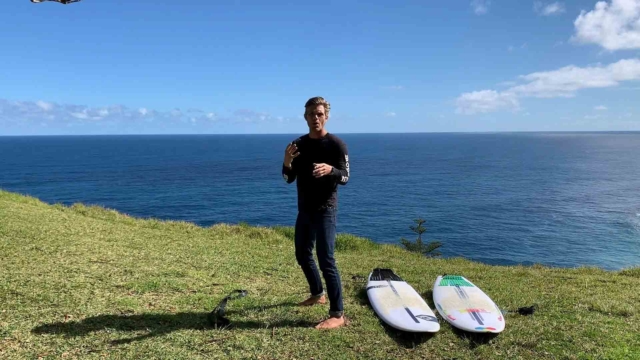
I want you to understand the Why’s behind the need for a better surf stance. And understand the Why’s behind a poo-man stance literally stalling and inhibiting any chance of progression.
I have found now through years of being a trainer, coach, and surf coach, that if you can give someone a deeper understanding of the reasoning and rationale behind something, an “aha” moment of enlightenment, then the new options (a better surf stance) become easier to replicate. Understanding allows for Action to create change, which leads to better Choices in the water, ultimately becoming better skill.
So here are the Why’s.
What is the perfect surf stance? Let’s define it.
The Perfect Surf Stance:
A dynamic posture allowing for fluid movement due to efficient skeletal positioning and maintenance of the body’s center of gravity over a moving and fluid surface. Optimal alignment of joints to permit rotational ranges of motion, and allowing a spring-like action to occur through the joint centers of the lower body. A balanced position creating even weight distribution with allowance for pressure differentials to influence surfboard rails based on the movement of the upper body.
I just made that up, but it sounds fairly spot on. Bio-mechanically it is 100% spot on and correct, but to you, it probably makes absolutely no sense at all, which is fine, it’s a lot of professional jargon really that I would say to impress other surf coaches.
Here are the basics of the surf stance: Stand in a spring-like forward-facing stance so you can easily move in all directions, up, down, and rotationally.
It’s an athletic stance, almost like a boxer being light on their toes, and springing through the hips and knees. At its lowest point, full compression, think of a tiny little barrel crouch, it is what I refer to as a sprinter position. That sprinter in the blocks ready to run position, capable of exploding forward and producing momentum. At its highest point, extension, it’s that stacked boxer / fighter stance, capable of being a spring.
Andy Irons from the Trilogy Film – Athletic Forward Facing Spring-like Posture
It is an alignment and “posture” of the body that allows for freedom of movement in all directions, and respects the need to create forward inertia and movement (down the line). Rob Machado is a beautiful representation of this.
Rob Machado – The Perfect Surf Stance
The poo-man stance directly opposes the ability to move in all directions, and directly opposes forward momentum or inertia. You’ll see this example in the accompanying video with my absolutely perfect rendition of the poo man, which I hope you find hilarious and insightful.
You’ll notice that I touch upon the aspect of the poo stance literally having half of the body facing backwards, stalling any forward momentum. This is a big problem, as surfing is inertia driven, forward facing momentum, and having one half of the body pointing in the wrong direction creates opposing and awkward forces.
Coordinate your body directionally speaking to help with momentum, inertia, and drive down the line.
This improved athletic and spring-like surf stance also allows for accessible movement into other planes of motion, and the movements required by progressive surfing.
Good surfing requires 3 primary movement components:
Twisting, Leaning, and Compression (as well as Extension, which is the opposite of compression and refers to the spring-like motion I’ve mentioned).
Since those are the 3 necessary movement patterns in surfing, then your perfect surf stance needs to be a position which allows for free and fluid movement into any of those positions.
This leads us towards a discussion of Posture.
Posture and Your Perfect Surf Stance
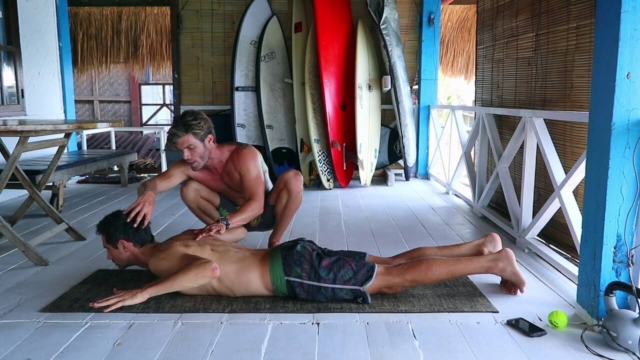
Posture is at its essence defined by how you hold your body in gravity. More deeply it’s about how your joints stack upon one another and the relationship of muscles and connective tissue maintaining them in that position, and even deeper is how it’s all really controlled by your brain (nervous system).
This aspect of joint position is vitally important because of how one joint sits in relation to other joints affects how both joints can move. It can effect the ability to move freely, and effect the ability to move through full range of motion (meaning “mobility”).
This is THE REASON that a poo-man stance is utterly terrible from not only a movement perspective, but visually it looks like you’re trying to take a dump. It places joints into positions that create an inability to move freely, limits joint movement, and therefore a loss of overall mobility. An immobile surfer is a stiff, awkward looking surfer.
Your poo stance is literally forcing you to be a stiff and awkward surfer with no capacity for progression.
For a movement based example of this relationship I want you to stand up or sit upright as tall as you can with a “perfect” posture. An upright spine, a well-positioned head atop the neck and shoulders, and an elevated rib cage…. Be upright… you get the idea.
From this position, reach your arms forwards and then overhead, as high as you can. Feel that position and be aware of how high you could raise your arms, the ease with which you could move, and how your shoulders feel.
Now, let go of that “perfect” posture, and slouch. Slouch into the nastiest computer posture possible. Let the spine round excessively, allow the head and jaw to jut forward into space. Slouch as much as you can possibly slouch.
Maintaining this slouch position, try to raise your arms forward and then overhead as high as you can, while keeping that slouch in the spine and head position. You didn’t get your arms as high, did you? It probably even felt grossly uncomfortable in your shoulder joint.
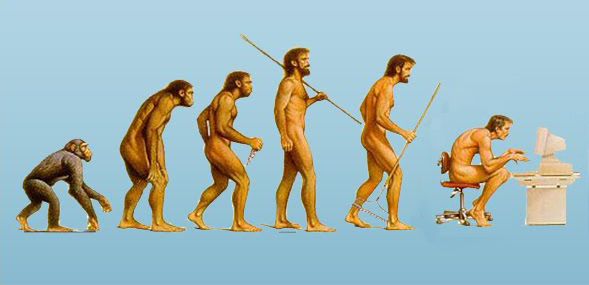
Your “posture”, the positioning of joints in relation to one another, affected your ability to move your shoulder and arm.
Your posture and joint position affected your ability to move well, move freely, and move fluidly.
What you’ve just felt is the exact reason a poo man stance will literally stop any chance you have of surfing progression. It not only looks awful but it is literally placing your joints into a position where they are unable to move freely.
You can’t twist, you can’t be a spring, and you can’t lean from a poo-man stance.
The poo-man stance is essentially a survival reflex mechanism driven by your brain to balance on a highly unstable surface. It’s essentially a stress reaction. It happens naturally when someone starts surfing in order to maintain their balance on an unstable moving surface, and it becomes engrained in their surfing, and often never improved upon.
This is why it plagues the spectrum of beginner and intermediate surfers.
If you were to walk out onto a frozen lake right now, having never stood on ice before, you would start to slip and slide, and move in any way possible in an attempt to not fall.
Your immediate brain-driven inclination would be to throw the arms out wide and lower into a squat position creating a lower center of gravity and a wider base of support.
This is the poo-man. This is the survival mechanism in a sense, brain-driven, to maintain your balance on an unstable surface.
What works initially for you to stand on that foamy surfboard learning to surf is the poo stance. It serves its purpose. You stand wide, throw your arms out, and balance on your first ever wave. Yewwww! Now you’re hooked on surfing.
The issue is that this stance that worked for a beginner is often never unlearned by those surfers moving into the expansive realm of intermediate surfing.
The posture of a poo stance, and how it inhibits your ability to move freely, literally prevents you from surfing the way you want to if you have an aim towards progression.
I want to give you one last example to drive this home, and it’s another that you really should stand up and feel. Feeling creates physical awareness, and that awareness allows for more efficient change (change to your stance).
From a mechanical perspective, there is a lot of similarity in a golf swing with how you as a surfer need to move. A golf swing is all spirals and rotation, and at its essence, surfing is the same. I won’t bore you with my tangential deep thoughts about surfing mechanics and helix spirals…… But the golf swing is a great example.
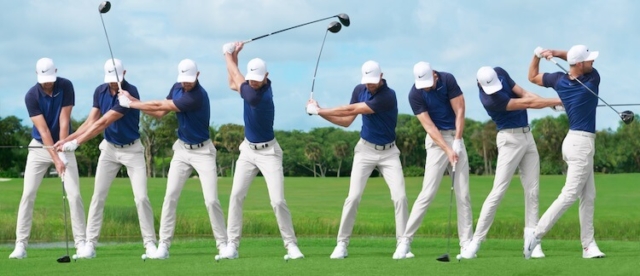
Stand up in a good posture, elongated alignment of the spine, no slouching, and perform a golf swing, even if you don’t have a club, just mimic the movement. It should be fairly effortless and you should feel the rotation from head to toe. You’re in a postural alignment that allows all joints to contribute to the movement.
Now, get into a full poo-man stance. Exaggerate it even. Get low, stick the butt out, one foot points forwards, while the other foot points backward. Maintaining this poo position, perform a golf swing.
It felt terrible, didn’t it? Horrible, clunky, awkward, and stiff.
That is exactly why your surfing poo stance results in horribly, clunky, awkward, and stiff surfing.
The low squat poo man position puts you into a posture that inhibits your ability to move fluidly. You can’t extend, you can’t compress, and you can’t twist, therefore you can’t surf.
Please take note of my point up above of having one foot forwards, and the back foot facing backwards in that poo stance. I detail this in the accompanying video you’ll find in this post, as this foot position is a massive hindrance to surfing. Placing your feet in opposing directions is literally one of the worst things you can do to your surf stance due to the relationship of the foot, hip, and those joints influencing your ability to move freely, or move rigidly and awkwardly.
Not to mention that this opposing foot stance is also potentially setting you up for some type of serious joint injury from the accumulated forces it places into the joints of the knee and hip.
What can you take from all this?
The poo-stance is bad.
It not only looks terrible, but it is literally preventing you from progressing with your surfing.
The Perfect Surf Stance
So what is the perfect surf stance?
I want to be clear with this: There is NO 1 perfect right and correct way.
There is nuance to this. There is individual style. And there is variety. This is surfing.
Yet there are commonalities and underlying principles.
Mick Fanning surfs differently than Italo Ferreira, yet they’re both world champions, have incredibly high levels of skill, and they have quite different “styles” and stances at times. However despite these differences there are commonalities among them, and it is these commonalities that we can agree upon.
What I propose below are surf stance commonalities that allow for surfing growth and progression.
For the examples I provide I have no doubt you can find a singular screen grab moment where a pro is doing something different to what I outline. But that does not imply these commonalities are wrong. You happened to find a brief moment of an outlier, and that is to be expected. Surfing is Movement, which in and of itself is highly variable.
If you simply begin to watch surf videos with the movement characteristics I outline, you’ll see them repeated over and over and over.
A surfer that I think is absolutely top of the pack in terms of style and skill is Ethan Ewing. If you haven’t heard of him yet you will in the next few years. He was the world junior champ a few years ago and he’s been making some solid WCT heats this last year. Check out his style, and pay attention to all the movement commonalities I mention.
Ethan Ewing – Pure Style
The Perfect Surf Stance Commonalities
Please watch the accompanying youtube video of mine so you have a visual representation of this. I’m simply going to throw the list out below in short form. In the video, I dive into specifics and give you movement examples of all of this.
Spring-like action of the lower body
-use the joints of the leg as a spring, not a singular hinge point of bending forward
Stacked upright posture to allow for freedom of rotation
Directionally Forward Facing
-Chest forwards
-Pelvis angled forwards
-Knees forwards
Coordinated Arms with Directional Intention
-where your arms go your board will go, so perhaps you should stop flinging your arm backwards everytime you try and do a turn.
Foot Position
-your foot position will effect the alignment and mobility of all joints up the kinetic chain
The Perfect Surf Stance Foot Position
To be clear, we are discussing shortboards here.
I want to make this as simple as possible and again remind you that there is nuance to this depending on what pro surfer you’re looking at.
Stance width will vary depending on body characteristics.
A 5 4” female will likely have a narrower stance than a 6 4” male. Some surfers have wider stances, Italo Ferreira is a good example of this, whereas Craig Anderson has a much narrower stance.
For a generalization, if you were standing with feet together, and then took a normal distance step forward with one foot, you’d then have one foot forwards and one foot back. Your surf stance would probably be a bit wider than that distance, perhaps around 1.5x’s that distance give or take. Please take into account this distance varies! You’ve got to find the stance that works for your body and feels natural.
Your front foot should be somewhere in the vicinity of perpendicular to the stringer to a 45 degree angle facing forwards. Somewhere around there give or take some degrees. Personally I’m around the 30-40 degree angle forward of the stringer. It’s this slightly forward angle of the foot that allows the hip and pelvis to be directionally forward facing more easily due to the architecture of the hip socket and femoral head (thigh bone).
The back foot is where there is variability and this seems to be a massive point of confusion for the intermediate spectrum of surfers.
Your back foot moves!
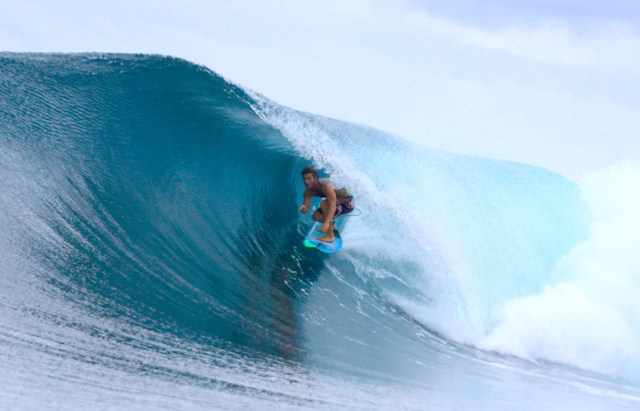
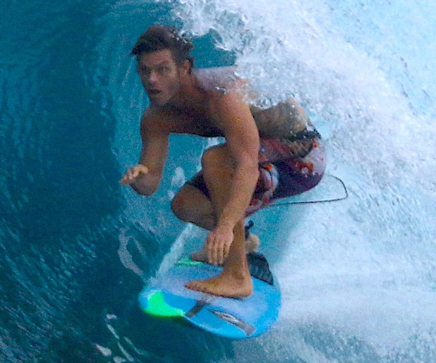
A little tube time for me in the Banyaks on one of our Surf Coaching Boat Trips… You should join us! SURF TRIPS
Not only will you see my forward facing barrel crouch position, being a spring and directionally intentional with my posture. But you should also zoom in on my back foot. The heel isn’t even on the board! I’ve pivoted up onto the big toe to allow for better crouching while still maintaining rail pressures to remain engaged in the tube!
Your back foot can and should move depending on what you’re doing with your surfing! A full barrel crouch on your forehand and you’re probably just on the ball of the foot and the big toe.
You can see that represented in my photo. If you’re pumping down the line to make speed you may have your back foot in front of the tail pad. If you’re trying to blow fins out the back of a lip your foot is probably all the way back against the tail pad riser.
The more progressive your surfing becomes, the more you will realize that your back foot is not stationary. It moves around depending on your intent to maneuver the board.
Generally speaking you want that back foot right on top of that tail pad, just about as far back as your foot can comfortably go. This is presumably directly atop the fins, therefore giving you maneuverability. But again, I can’t stress enough that your back foot should become mobile in terms of placement with surfing progression.
Similar to the angle mentioned earlier, you tend to want a perpendicular to the stringer back foot position and even into the 30-45deg angle of forward inclination I mention.
This forward inclination of the foot again allows for better movement through the joints of the lower body and allows you to more efficiently orient the pelvis and back knee to a forward facing position.
What About Backhand Surfing?
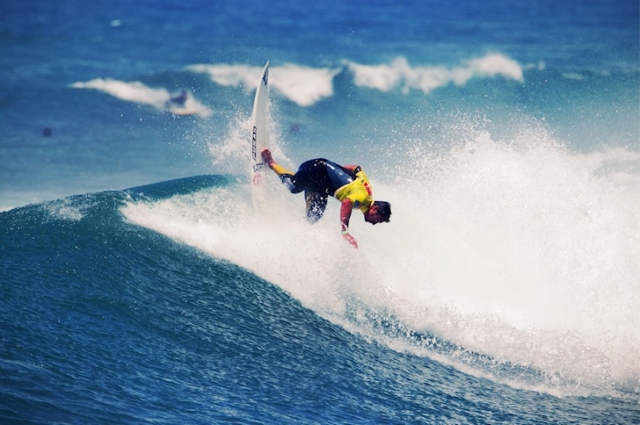
Backhand can be slightly more cumbersome.
It can literally feel a bit more awkward as your back is to the wave and mechanics are slightly different.
Yet the main points still apply. Orient yourself more forward facing, which can immediately be implemented by reaching your rear arm where you want to go. Yes, your rear arm. People will inevitably ask, which boggles my mind, but again, your rear arm! Natural footers, that’s your right arm. Goofy footers, that’s your left arm. No, it doesn’t matter if you’re surfing a left or a right hand wave, your back arm is always your back arm.
Reach that back arm where you want to go! Always and forever. This is a topic for another post, but take heed: If you reach your back arm in the direction that you want to go it will orient the rest of your body in the correct direction.
So please, for the love of good surfing, stop throwing your back arm backwards and flailing it around.
I’ve literally just changed your surfing via this back arm positioning. Don’t undermine this aspect, as it can catapult your surfing.
Back to the point of a backhand. Get that rear arm facing the direction you want to be going, and it will help to orient your chest and pelvis in the direction you want to go.
With specific regard to foot positioning, on a backhand there will be a tendency for the rear foot to slightly point backwards. This is in fact ok and allows for better compression of the rest of the body. If it points slightly backwards it’s easier to roll onto the inside of the foot and then compress down into stance position, whereas on the forehand it can roll up onto the big toe joint and the heel elevates off the board.
Biomechanically and orthopedically, that rear foot position isn’t the nicest. But you will tend to see most surfers, even elite-level pros, allow that back foot to rotate and point slightly backward on their backhand.
An amazing backhand surfer to watch is Bobby Martinez. I’m telling you, repeatedly… watch his rear arm!
Bobby Martinez at Rincon
Go Surf & Improve Your Surf Stance
This may be a lot to take on. But you should have a more enlightened awareness of what a good surf stance is versus what a poo-man stance is. Your surfing progression really depends on it.
With your new awareness, take this perception to your local surf break. I have no doubt you’ll see things very differently now, with glaring inefficiencies in others surfing.
This new awareness is the key to change and progression.
Changing habit, postures and positions in the water can take time. But simply start with the basics.
Chest facing where you want to go. Become comfortable with weight on that front leg and reach your rear arm in the direction you’d like to surf.
If you’re ready to truly change your awareness of surfing, and practice technique on dry land, be sure to have a look at the Cardboard Surfer or the Surf Skate Fundamentals Program

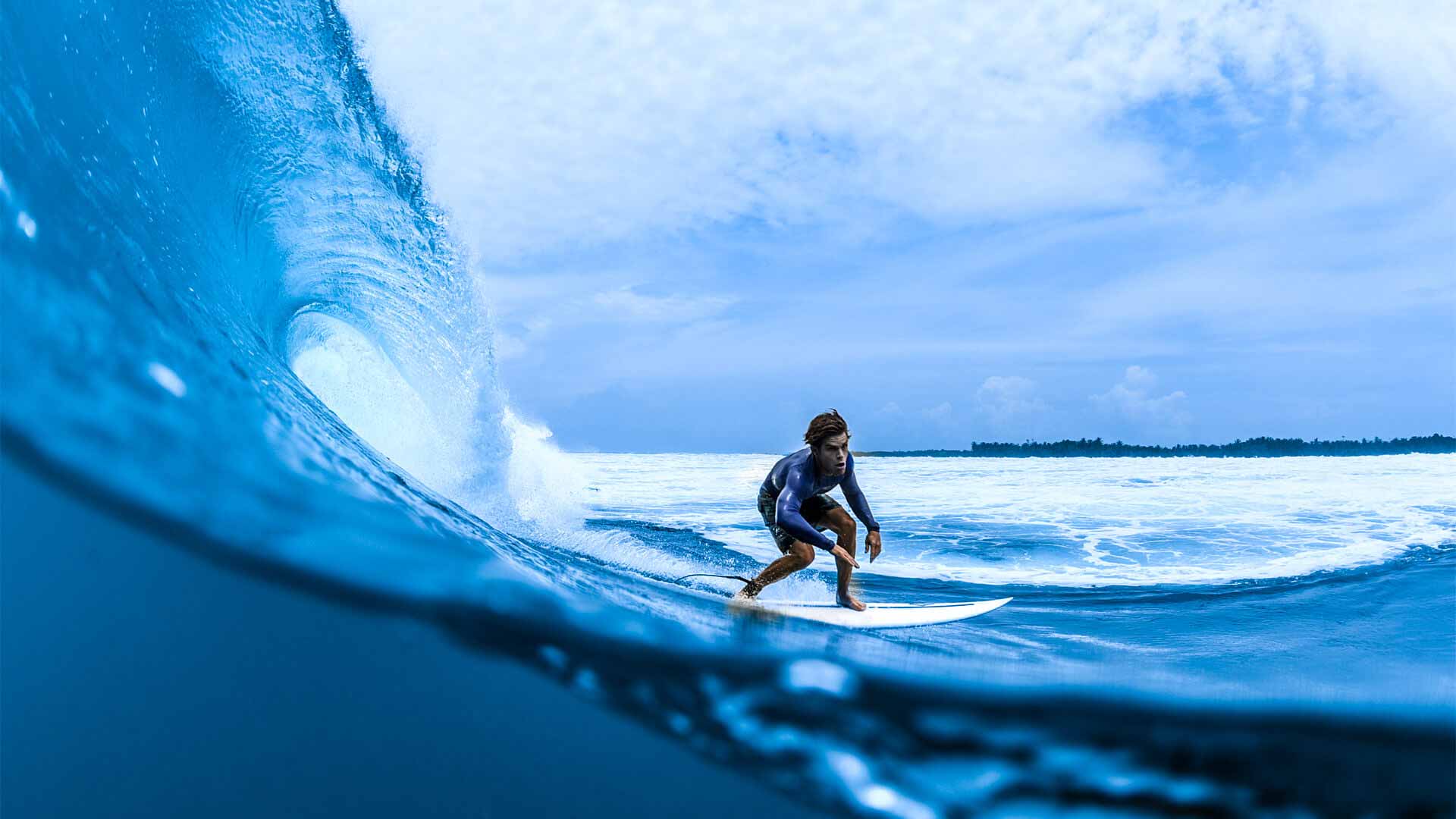
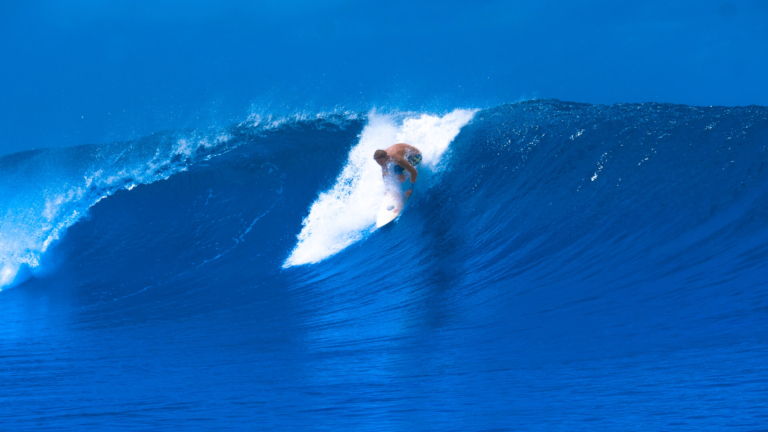
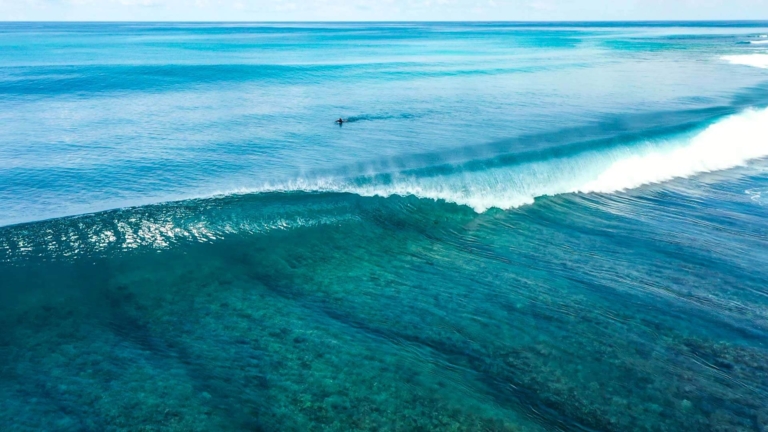
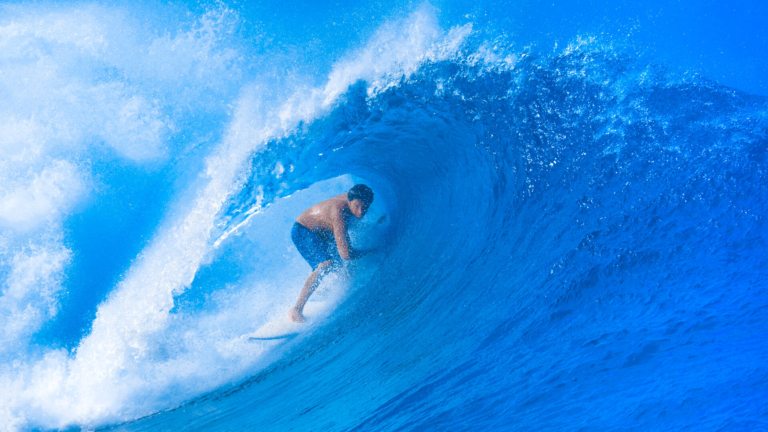

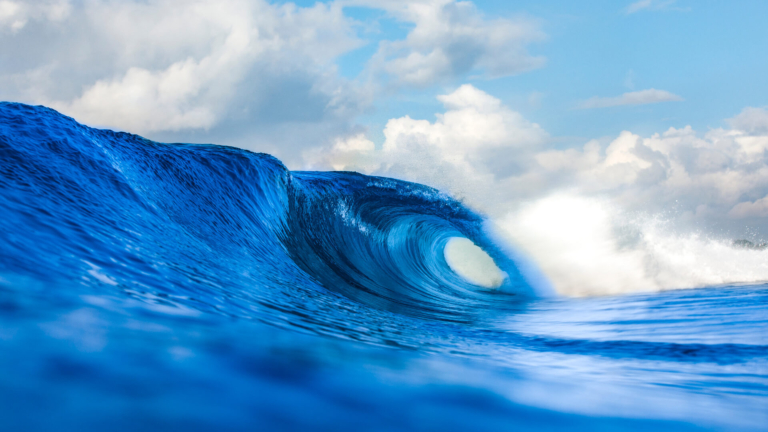
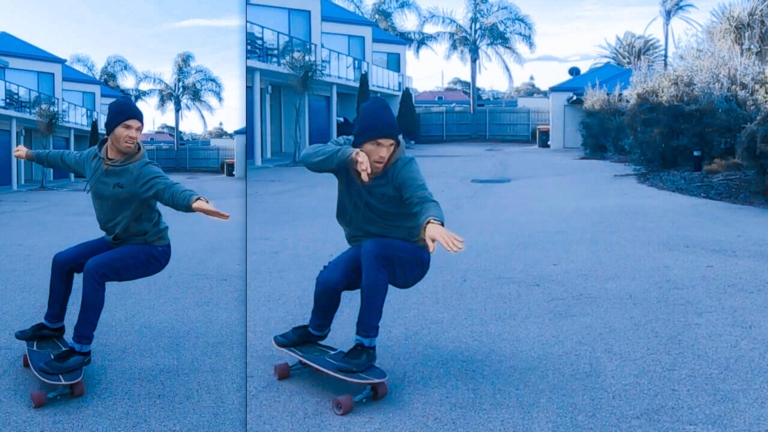
It’s a good post for many surfers, including beginners. 양양 서핑